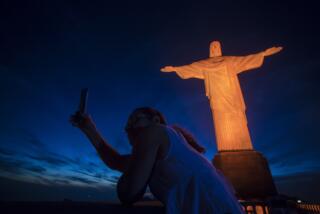Pilot Program May Boost Travel : U.S. and Japan Waive Visas for Each Other’s Tourists
- Share via
TOKYO — Japanese and American tourists and executives can travel to each other’s country without a visa beginning Thursday under a pilot program that could boost the flow of free-spending Japanese to America.
Travel industry spokesmen were unanimous in welcoming the change for, if nothing else, ending the hassle of spending time or money to get a visa.
The change will result in a bit more paper work for the airlines and a lot less for the U.S. Embassy in Tokyo. Expectations on both sides are that Japanese travel to the United States will increase.
Spending an average $1,000 each aside from airline tickets, 2.2 million Japanese travelers went to the United States in 1987, the most from any country. The projection for 1988 is 2.6 million U.S.-bound travelers, said Fritz M. Schmitz, regional director of the U.S. Travel and Tourism Administration, an arm of the Commerce Department.
Only 430,000 American tourists and executives visited Japan in 1987, making tourism one of the few sectors where the United States has a trade surplus with Japan--about $1 billion last year.
Schmitz said it wasn’t clear how much effect the visa-waiver program would have, but some in the industry predict a 10% increase in U.S.-bound travel from Japan.
1986 Law
“Those of us in tourism promotion have been pushing for it for years,” Schmitz said in a telephone interview. “Freedom to travel is an important part of better international relations.”
He acknowledged that the United States, still a magnet for immigration, was more difficult for tourists to enter than some other countries. Americans can enter most European countries without a visa, but Europeans have to obtain visas to travel to America.
In 1986, Congress passed a law authorizing negotiations with other countries to waive certain visa requirements. The first agreement, with Britain, went into effect in July, and Japan is the second to embark on a pilot program that will be reassessed in 1991.
Robyn Bishop, chief of the visa branch at the U.S. Embassy, cautioned that the waiver was voluntary and that some travelers probably would still want a visa stamped in their passports. The waiver doesn’t apply to people intending longer stays, such as students, journalists, researchers, exchange visitors or people about to marry and move to the United States, Bishop said.
Right Kind of Traveler
Travelers without visas will have to convince immigration officers at U.S. entry points that they are a bona fide tourist or executive by producing a return ticket or one for another destination, and there can be no extensions of the 90-day limit or appeals if a traveler is turned back, she said.
“We think the Japanese are the right kind of traveler to take advantage of the visa program,” she said. “They take short vacations, often in tour groups, on fixed itineraries.”
Bishop expected the new rule to shorten the lines outside the Tokyo embassy, which peaked at 1,665 one day in February, a time when many young Japanese travel after the school year ends and before they start jobs in April. She said about 95% of the 930,000 visas issued in Tokyo last year were for tourism and business visitors.
At the Japan Travel Bureau, which sent almost 400,000 people to the United States in 1987, spokesman Keiichi Tsujino said the change would ease inconvenience and stimulate more travel.
“For example, if a client thinks of going to the United States, he can go instantly,” Tsujino said. “This is a welcome change.”
More to Read
Sign up for Essential California
The most important California stories and recommendations in your inbox every morning.
You may occasionally receive promotional content from the Los Angeles Times.













